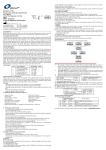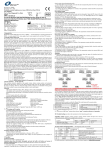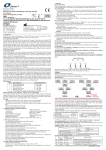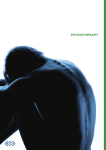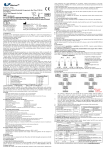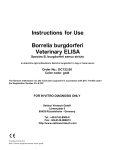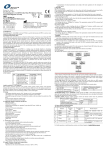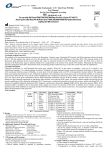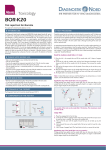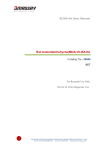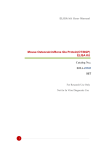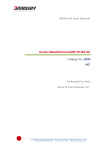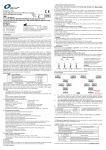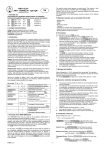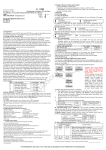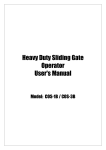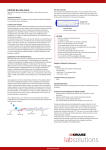Transcript
Revision No.: ZJ0003 Issue Date: Jul 1st, 2012 Borrelia burgdrferi (Bb) Real Time PCR Kit User Manual For In Vitro Diagnostic Use Only ED-0163-02 For use with ABI Prism®7000/7300/7500/7900/Step One Plus; iCycler iQ™4/iQ™5; Smart Cycler II;Bio-Rad CFX 96;Rotor Gene™6000; Mx3000P/3005P;MJ-Option2/Chromo4; LightCycler®480 Instrument Obelis S.A. Boulevard Général Wahis 53 1030 Brussels, BELGIUM Tel: +(32) 2.732.59.54 Fax: +(32) 2.732.60.03 E-Mail : [email protected] Shanghai ZJ Bio-Tech Co., Ltd. www.liferiver.com.cn Tel: +86-21-34680596 [email protected] Fax: +86-21-34680595 2nd floor,No.15 Building,No.188 Xinjunhuan Road, PuJiang Hi-tech Park, Shanghai, China 1. Intended Use The borrelia burgdrferi real time PCR kit is used for the detection of three species of borrelia burgdrferi in whole blood (non-anticoagulant), ticks, C.S.F, synovial fluid, or skin tissue samples by using real time PCR systems. 2. Principle of Real-Time PCR The principle of the real-time detection is based on the fluorogenic 5’nuclease assay. During the PCR reaction, the DNA polymerase cleaves the probe at the 5’ end and separates the reporter dye from the quencher dye only when the probe hybridizes to the target DNA. This cleavage results in the fluorescent signal generated by the cleaved reporter dye, which is monitored real-time by the PCR detection system. The PCR cycle at which an increase in the fluorescence signal is detected initially is proportional to the amount of the specific PCR product. Monitoring the fluorescence intensities in real-time allows the detection of the accumulating product without having to re-open the reaction tube after the amplification. 3. Product Description Borrelia burgdorferi is a species of Gram negative bacterium that causes Lyme disease. It is a zoonotic, vector-borne disease transmitted by ticks. It is common in the Northeastern, midwest and western US. These organisms are highly motile, microaerophilic, slow growing, and fastidious. Lyme disease is an inflammatory disorder characterized by the skin lesion erythema migrans and the potential development of neurologic, cardiac, and joint abnormalities. Three Borrelia species frequently cause Lyme disease in humans: Borrelia burgdorferi sensu stricto, Borrelia garinii, and Borrelia afzelii. Specific Borrelia species can cause distinct clinical manifestations of Lyme disease. B. burgdorferi can cause arthritis. B. garinii is known to cause serious neurological manifestations. B. afzelii causes a distinctive skin condition known as acrodermatitis chronica atrophicans. Each of the three Borrelia species causes a characteristic erythema migrans. The Borrelia burgdorferi real time PCR Kit contains a specific ready-to-use system for the detection of Borrelia burgdorferi(for B. burgdorferi sensu stricto,B. burgdorferi,and B. afzelii)through polymerase chain reaction (PCR) in the real-time PCR system. The master contains reagents and enzymes for the specific amplification of the malaria parasites DNA. Fluorescence is emitted and measured by the real time systems´ optical unit during the PCR. The detection of amplified Borrelia burgdorferi DNA fragment is performed in fluorimeter channel FAM with the fluorescent quencher BHQ1. DNA extraction buffer is available in the kit. In addition, the kit contains a system to identify possible PCR inhibition by measuring the HEX/VIC/JOE fluorescence of the internal control (IC). 4. Kit Contents Ref. Type of Reagent Presentation 25rxns 1 DNA Extraction Buffer 2 vials, 1.5ml 2 Bb Reaction Mix A 1 vial, 950µl 3 Bb Reaction Mix B 1 vial, 950µl 4 Bb Reaction Mix C 1 vial, 950µl 5 PCR Enzyme Mix 1 vial, 32µl 6 Molecular Grade Water 1 vial, 400µl 7 Internal Control A 1 vial,55µl 8 Internal Control B 1 vial,30µl 9 Bb Positive Control 1 vial, 90µl Analysis sensitivity: 1×104copies/ml Note: Analysis sensitivity depends on the sample volume, elution volume, nucleic acid extraction methods and other factors .If you use the DNA extraction buffer in the kit, the analysis sensitivity is the same as it declares. However, when the sample volume is dozens or even hundreds of times greater than elution volume by some concentrating method, it can be much higher. 5. Storage • All reagents should be stored at -20°C. Storage at +4°C is not recommended. • All reagents can be used until the expiration date indicated on the kit label. • Repeated thawing and freezing (>3x) should be avoided, as this may reduce the sensitivity of the assay. • Cool all reagents during the working steps. • Reaction mix should be stored in the dark. 6. Additionally Required Materials and Devices • Biological cabinet • Real time PCR system • Desktop microcentrifuge for “eppendorf” type tubes (RCF max. 16,000 x g) • Vortex mixer • Real time PCR reaction tubes/plates • Cryo-container • Pipets (0.5µl – 1000µl) • Sterile filter tips for micro pipets • Sterile microtubes • Disposable gloves, powderless • Biohazard waste container • Refrigerator and Freezer • Tube racks 7. Warnings and Precaution • Carefully read this instruction before starting the procedure. • For in vitro diagnostic use only. • This assay needs to be carried out by skilled personnel. • Clinical samples should be regarded as potentially infectious materials and should be prepared in a laminar flow hood. • This assay needs to be run according to Good Laboratory Practice. • Do not use the kit after its expiration date. • Avoid repeated thawing and freezing of the reagents, this may reduce the sensitivity of the test. • Once the reagents have been thawed, vortex and centrifuge briefly the tubes before use. • Quickly prepare the reaction mix on ice or in the cooling block. • Set up two separate working areas: 1) Isolation of the RNA/ DNA and 2) Amplification/ detection of amplification products. • Pipets, vials and other working materials should not circulate among working units. • Use always sterile pipette tips with filters. • Wear separate coats and gloves in each area. 8. Sample Collection, Storage and transportation • Collect samples in sterile tubes. • Specimens can be extracted immediately or frozen at -20°C to -80°C. • Transportation of clinical specimens must comply with local regulations for the transport of etiologic agents. 9. Procedure 9.1 DNA-Extraction DNA extraction buffer is contained in the kit, please thaw the buffer thoroughly and spin down briefly in the centrifuge before use. You may use your own extraction systems or the commercial kit. 9.1.1 Whole blood, C.S.F, ticks and synovial fluid samples 1) Pipet 100µl sample to a 0.5ml tube, add 100µl DNA extraction buffer, close the tube and vortex for 10 seconds. Spin down briefly in a table centrifuge. 2) Incubation the tube for 10 minutes at 100°C. 3) Centrifuge the tube at 13000rpm for 10 minutes. The supernatant contains the DNA extracted and is used for PCR template. 9.1.2 Skin tissue samples 1) Take 50mg sample to a tube, add 100µl DNA extraction buffer, close the tube then vortex for 10 seconds. Spin down briefly in a table centrifuge. 2) Incubate the tube for 10 minutes at 100°C. 3) Centrifuge the tube at 13000rpm for 10 minutes. The supernatant contains the DNA extracted and can be used for PCR template. Attention: A. During the incubation, make sure the tube is not open, as the vapor will volatilize into the air and may cause contamination if the sample is positive. B. The extraction sample should be used in 3 hours or store at -20°C for one month. C. Different brand DNA extraction kits are available. You can also use your own extraction systems or the commercial kit based on the yield. For the DNA extraction, please comply with the manufacturer’s instructions. 9.2 Internal Control It is necessary to add internal control (IC) in the reaction mix. Internal Control (IC) allows the user to determine and control the possibility of PCR inhibition. Add the internal control (IC) 1µl/rxn and the result will be shown in the HEX/VIC/JOE. 9.3 PCR Protocol The Master Mix volume for each reaction should be pipetted as follows: OR ※ ※ PCR system without HEX/VIC/JOE channel may be treated with 1µl Molecular Grade Water instead of 1µl IC. 1) The volumes of Reaction Mix and Enzyme Mix per reaction multiply with the number of samples, which includes the number of the controls and sample prepared. Molecular Grade Water is used as the negative control. For reasons of unprecise pipetting, always add an extra virtual sample.Mix completely then spin down briefly in a centrifuge. Pipet 36µl (22.5µl for SmartCycer II) Master Mix with micropipets of sterile filter tips to each real time PCR reaction plate/tube. Then separately add 4µl (2.5µl for SmartCycer II) DNA sample, positive and negative controls to different reaction plate/tubes. Immediately close the plate/tubes to avoid contamination. Spin down briefly in order to collect the Master Mix in the bottom of the reaction tubes. Perform the following protocol in the instrument: 37°C for 2min 1cycle Selection of fluorescence channels 94°C for 2min 1cycle FAM Target Nucleic Acid 93°C for 15sec, 60°C for 1min HEX/VIC/JOE IC 40cycles ( Fluorescence measured at 60°C) 2) 3) 4) 5) There are 3 different kinds of Reaction Mix and 2 different kinds of Internal Control. According to the table below, each reaction mix should be added with its own internal control. Reaction Mix A Internal Control A Reaction Mix B Internal Control A Reaction Mix C Internal Control B If you use ABI Prism® system, please choose “none” as passive reference and quencher. 10. Threshold setting: just above the maximum level of molecular grade water. 11. Quality control: Negative control, positive control and internal control must be performed correctly, otherwise the sample results is invalid. Channel Ct value Control FAM HEX/VIC/JOE Molecular Grade Water UNDET 25~35 Positive Control(qualitative assay) ≤35 —— 12. Data Analysis and Interpretation :The following results are possible: Ct value Result Analysis FAM HEX/VIC/JOE 1# UNDET 25~35 Below the detection limit or negative 2# ≤38 Positive; and the software displays the quantitative value —— 3# 25~35 Re-test; if it is still 38~40, report as 1# 38~40 4# UNDET UNDET PCR Inhibition; no diagnosis can be concluded. Channel FAM; Ct value≤38 Reaction Mix A Reaction Mix B Reaction Mix C Species B. burgdorferi sensu stricto B. garinii B. afzelii For further questions or problems, please contact our technical support at [email protected] Result
